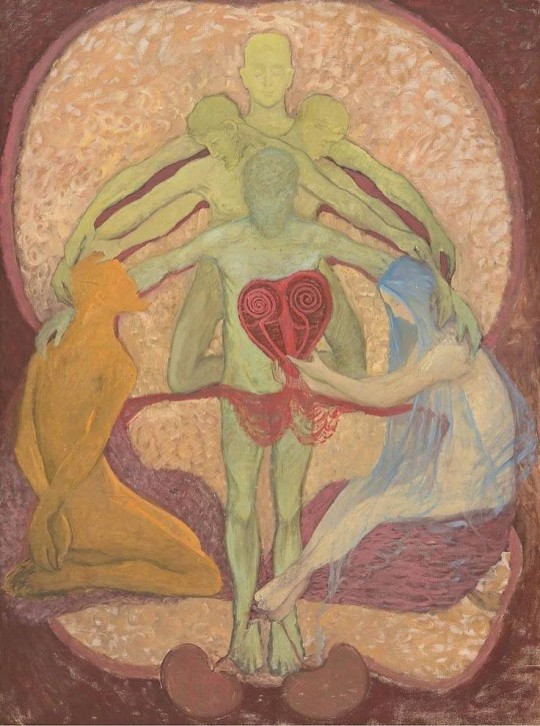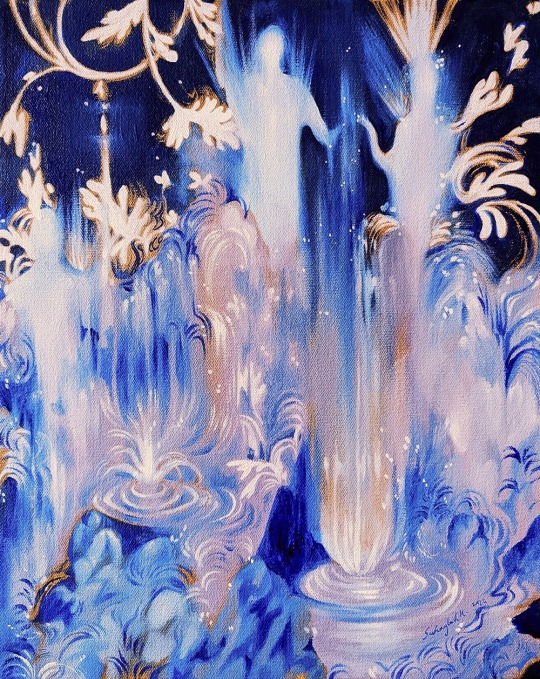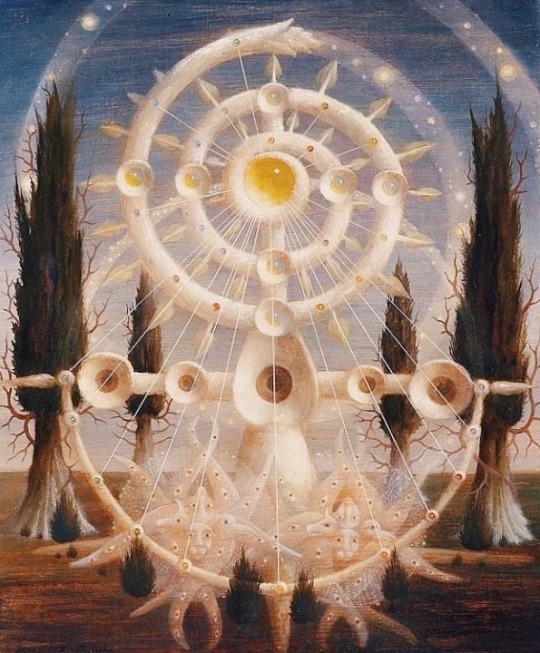#Mysticism
Text
You can believe in magic, but watch out.
45K notes
·
View notes
Text

The Rose, Nr4, by Hilma af Klint, 1907.
#hilma af klint#female artists#the rose#symbolism#art#painting#spiritualism#heart#transcedence#abstract art#mysticism#theosophy
3K notes
·
View notes
Text
Emerald Spectacles from India, c. 1620-1660 CE: the lenses of these spectacles were cut from a single 300-carat emerald, and it was believed that they possessed mystical properties

These eyeglasses are also known by the name "Astaneh-e ferdaws," meaning "Gate of Paradise," based on the perception of the color green as a symbol for spiritual salvation/Paradise. This was a common belief in Mughal-era India, where the spectacles were made.

The lenses were crafted from two thin slices of the same emerald. Together, the lenses have a combined weight of about 27 carats, but given the precision, size, and shape of each lens, experts believe that the original emerald likely weighed in excess of 300 carats (more than sixty grams) before it was cleaved down in order to produce the lenses. The emerald was sourced from a mine in Muzo, Colombia, and it was then transported across the Atlantic by Spanish or Portuguese merchants.
Each lens is encircled by a series of rose-cut diamonds, which run along an ornate frame made of gold and silver. The diamond-studded frame was added in the 1890s, when the original prince-nez design was fitted with more modern frames.

The emerald eyeglasses have long been paired with a second set of spectacles, and they were almost certainly commissioned by the same patron. This second pair is known as Halqeh-e nur, or the "Halo of Light."
The Halo of Light features lenses that were made from slices of diamond. The diamond lenses were cleaved from a single stone, just like the emerald lenses, with the diamond itself being sourced from a mine in Southern India. It's estimated that the original, uncut diamond would have weighed about 200-300 carats, which would make it one of the largest uncut diamonds ever found.

These lenses are so clear and so smoothly cut that it sometimes looks like they're not even there
Both sets of spectacles date back to the mid-1600s, and it's generally believed that they were commissioned by a Mughal emperor or prince. The identity of that person is still a bit of a mystery, but it has been widely speculated that the patron was Shah Jahan -- the Mughal ruler who famously commissioned the Taj Mahal after the death of his wife, Mumtaz Mahal. Shah Jahan did rule as the Mughal emperor from about 1628 to 1658.
The emerald and diamond lenses may have been chosen for symbolic/cultural reasons, or they may have been chosen simply because they're pretty and extravagant; their meaning/purpose is unclear. Experts do believe that the eyeglasses were designed to be worn by someone, though.
It was believed that the spectacles had spiritual properties, like the ability to promote healing, ward off evil, impart wisdom, and bring the wearer closer to enlightenment. Those beliefs are often related to Indic and Islamic traditions, some of which ascribe spiritual and/or symbolic traits to emeralds and diamonds. Emeralds can be viewed as an emblem of Paradise, divine salvation, healing, cleansing, and eternal life; diamonds are similarly associated with enlightenment, wisdom, celestial light, and mysticism.

The Gate of Paradise and the Halo of Light were both kept in the collections of a wealthy Indian family until 1980, when they were sold to private collectors, before going on auction once again back in 2021. They were valued at about $2 million to $3.4 million per pair.
Sources & More Info:
Sotheby's: Mughal Spectacles
Architectural Digest of India: At Sotheby's auction, Mughal-era eyeglasses made of diamond and emerald create a stir
Only Natural Diamonds: Auspicious Sight & the Halqeh-e Nur Spectacles
The Royal Society Publishing: Cleaving the Halqeh-Ye Nur Diamonds
Gemological Institution of America: Two Antique Mughal Spectacles with Gemstone Lenses
Manuscript: From Satan's Crown to the Holy Grail: emeralds in myth, magic, and history
CNN: The $3.5 million Spectacles Said to Ward off Evil
BBC: Rare Mughal Era Spectacles to be Auctioned by Sotheby's
#history#archaeology#artifact#mughal#india#17th century#art#emerald#diamond#glasses#indian lore#islam#religion#mysticism#indian history#anthropology#spirituality#fashion
4K notes
·
View notes
Text
Friendly reminder that:
The concept of starseeds promotes ableism by minimizing or denying ADHD and autism.
The ancient astronaut hypothesis promotes spiritual colonialism and destruction of other cultures by twisting other people's mythologies and sacred texts to fit their narratives.
The reptilian alien mythology is based on conspiracy theories historically used to justify oppressing and murdering real people. Loosh/blood/adrenochrome harvesting is just repackaged blood libel.
New Age mythology is chock full of repackaged right wing conspiracy theories, the same kind pushed by QAnon.
It's also full of repackaged racist pseudoscience about genetic superiority/inferiority and the function of evolution.
Ascension to 5D was supposed to have happened back in 2012, and the prediction failed.
New Agers are recycling their predictions over and over to catch new waves of people who don't know the movement's history.
Belief in Atlantis is strongly motivated by white supremacy.
For more info, see:
Looks like it's time to talk about starseeds and the New Age movement again.
How the mythology of starseeds, indigo children, crystal children, rainbow children, etc. harms kids
New Age YouTube channel caught recycling claims of imminent "first contact" for three years
Is the spiritual person a conspiracy theorist? A list of red flags
What is spiritual eugenics?
New Age beliefs that derive from racist pseudoscience
#starseed#starseeds#atlantis#ascension#5d#ancient aliens#ancient astronauts#ancient astronaut hypothesis#aliens#spiritualism#mysticism#dna activation#witchblr#new age#conspirituality#conspiracism
1K notes
·
View notes
Text
idea: build an altar to yourself. include dried petals from your favorite flowers. a candle in your favorite scent. include a figurine of a wolf if you're a wolf, of an angel if you're an angel. burn incense. play your favorite song. lay back and close your eyes and... honor yourself. you know?
#the void speaks#otherkin#kin#therian#therianthropy#spirituality#meditation#mysticism#wolf kin#wolf therian#nonhuman#alterhuman#angelkin#fallen angelkin#demonkin#voidkin#voidpunk#starkin#divinekin#godkin#deitykin#alienkin#actually angelic#otherkin positivity#monsterkin#dragonkin#robotkin#dollkin#winged kin#aviankin
2K notes
·
View notes
Photo

Dancers (2022)
shop: suhaylah.bigcartel.com
ig: @suhaylah.h
#art#painting#suhaylah#suhaylah h#surrealism#symbolism#oil painting#magical painting#dancers#mysticism#symbolist art#surrealist art#art aesthetic#magic aesthetic#magical art#fairycore
15K notes
·
View notes
Photo

Caroline Walker Bynum, The Female Body and Religious Practices in the Later Middle Ages
3K notes
·
View notes
Text

Scientific future by Valentino Bellucci
#sacred geometry#geometry#science#valentino belluci#Pythagoreans#mathematical#mysticism#Valentino Bellucci#u
1K notes
·
View notes
Text
So, a big name account here that talks about mysticism and has definitely made money on discussions of Jewish mysticism (they have a seemingly well-funded Patreon, among other things) has now said "No Zionists on my page" without actually, you know, specifying what they think a Zionist is.
I dunno, but isn't that pretty textbook cultural appropriation? I'm sure they'd say that Good anti-Zionist Jews are welcome, but that's the minority, and once people start putting up these lines, how long before any Jew is suspect?
We all know the answer.
Anyway, I hope that fellow Jews who have supported this user stop doing so now.
645 notes
·
View notes
Text
The Coprophagic AI crisis

I'm on tour with my new, nationally bestselling novel The Bezzle! Catch me in TORONTO on Mar 22, then with LAURA POITRAS in NYC on Mar 24, then Anaheim, and more!

A key requirement for being a science fiction writer without losing your mind is the ability to distinguish between science fiction (futuristic thought experiments) and predictions. SF writers who lack this trait come to fancy themselves fortune-tellers who SEE! THE! FUTURE!
The thing is, sf writers cheat. We palm cards in order to set up pulp adventure stories that let us indulge our thought experiments. These palmed cards – say, faster-than-light drives or time-machines – are narrative devices, not scientifically grounded proposals.
Historically, the fact that some people – both writers and readers – couldn't tell the difference wasn't all that important, because people who fell prey to the sf-as-prophecy delusion didn't have the power to re-orient our society around their mistaken beliefs. But with the rise and rise of sf-obsessed tech billionaires who keep trying to invent the torment nexus, sf writers are starting to be more vocal about distinguishing between our made-up funny stories and predictions (AKA "cyberpunk is a warning, not a suggestion"):
https://www.antipope.org/charlie/blog-static/2023/11/dont-create-the-torment-nexus.html
In that spirit, I'd like to point to how one of sf's most frequently palmed cards has become a commonplace of the AI crowd. That sleight of hand is: "add enough compute and the computer will wake up." This is a shopworn cliche of sf, the idea that once a computer matches the human brain for "complexity" or "power" (or some other simple-seeming but profoundly nebulous metric), the computer will become conscious. Think of "Mike" in Heinlein's *The Moon Is a Harsh Mistress":
https://en.wikipedia.org/wiki/The_Moon_Is_a_Harsh_Mistress#Plot
For people inflating the current AI hype bubble, this idea that making the AI "more powerful" will correct its defects is key. Whenever an AI "hallucinates" in a way that seems to disqualify it from the high-value applications that justify the torrent of investment in the field, boosters say, "Sure, the AI isn't good enough…yet. But once we shovel an order of magnitude more training data into the hopper, we'll solve that, because (as everyone knows) making the computer 'more powerful' solves the AI problem":
https://locusmag.com/2023/12/commentary-cory-doctorow-what-kind-of-bubble-is-ai/
As the lawyers say, this "cites facts not in evidence." But let's stipulate that it's true for a moment. If all we need to make the AI better is more training data, is that something we can count on? Consider the problem of "botshit," Andre Spicer and co's very useful coinage describing "inaccurate or fabricated content" shat out at scale by AIs:
https://papers.ssrn.com/sol3/papers.cfm?abstract_id=4678265
"Botshit" was coined last December, but the internet is already drowning in it. Desperate people, confronted with an economy modeled on a high-speed game of musical chairs in which the opportunities for a decent livelihood grow ever scarcer, are being scammed into generating mountains of botshit in the hopes of securing the elusive "passive income":
https://pluralistic.net/2024/01/15/passive-income-brainworms/#four-hour-work-week
Botshit can be produced at a scale and velocity that beggars the imagination. Consider that Amazon has had to cap the number of self-published "books" an author can submit to a mere three books per day:
https://www.theguardian.com/books/2023/sep/20/amazon-restricts-authors-from-self-publishing-more-than-three-books-a-day-after-ai-concerns
As the web becomes an anaerobic lagoon for botshit, the quantum of human-generated "content" in any internet core sample is dwindling to homeopathic levels. Even sources considered to be nominally high-quality, from Cnet articles to legal briefs, are contaminated with botshit:
https://theconversation.com/ai-is-creating-fake-legal-cases-and-making-its-way-into-real-courtrooms-with-disastrous-results-225080
Ironically, AI companies are setting themselves up for this problem. Google and Microsoft's full-court press for "AI powered search" imagines a future for the web in which search-engines stop returning links to web-pages, and instead summarize their content. The question is, why the fuck would anyone write the web if the only "person" who can find what they write is an AI's crawler, which ingests the writing for its own training, but has no interest in steering readers to see what you've written? If AI search ever becomes a thing, the open web will become an AI CAFO and search crawlers will increasingly end up imbibing the contents of its manure lagoon.
This problem has been a long time coming. Just over a year ago, Jathan Sadowski coined the term "Habsburg AI" to describe a model trained on the output of another model:
https://twitter.com/jathansadowski/status/1625245803211272194
There's a certain intuitive case for this being a bad idea, akin to feeding cows a slurry made of the diseased brains of other cows:
https://www.cdc.gov/prions/bse/index.html
But "The Curse of Recursion: Training on Generated Data Makes Models Forget," a recent paper, goes beyond the ick factor of AI that is fed on botshit and delves into the mathematical consequences of AI coprophagia:
https://arxiv.org/abs/2305.17493
Co-author Ross Anderson summarizes the finding neatly: "using model-generated content in training causes irreversible defects":
https://www.lightbluetouchpaper.org/2023/06/06/will-gpt-models-choke-on-their-own-exhaust/
Which is all to say: even if you accept the mystical proposition that more training data "solves" the AI problems that constitute total unsuitability for high-value applications that justify the trillions in valuation analysts are touting, that training data is going to be ever-more elusive.
What's more, while the proposition that "more training data will linearly improve the quality of AI predictions" is a mere article of faith, "training an AI on the output of another AI makes it exponentially worse" is a matter of fact.

Name your price for 18 of my DRM-free ebooks and support the Electronic Frontier Foundation with the Humble Cory Doctorow Bundle.

If you'd like an essay-formatted version of this post to read or share, here's a link to it on pluralistic.net, my surveillance-free, ad-free, tracker-free blog:
https://pluralistic.net/2024/03/14/14/inhuman-centipede#enshittibottification

Image:
Plamenart (modified)
https://commons.wikimedia.org/wiki/File:Double_Mobius_Strip.JPG
CC BY-SA 4.0
https://creativecommons.org/licenses/by-sa/4.0/deed.en
#pluralistic#ai#generative ai#André Spicer#botshit#habsburg ai#jathan sadowski#ross anderson#inhuman centipede#science fiction#mysticism
548 notes
·
View notes
Photo

Alphonse Osbert, Soir antique, 1908, oil on canvas painting, Musée des Beaux-Arts de la ville de Paris
1K notes
·
View notes
Text

by Ernst Steiner
#painting#art#occult#esoterist#esoteric painting#esoteric aesthetic#witchy aesthetic#visionary#transcendental#transcendent art#moodyvibes#whimsicore#dreamcore#liminal#esoteric#dream aesthetic#dream painting#dream vibes#mystical#mysticism#mystic aesthetic#enochian#paganism#whimsigoth#whimiscal#oil painting#vintage art#art history#weird art#trippy
547 notes
·
View notes
Photo

#ecthxs#sidewound#digital collage#stigmata#aesthetics#christianity#mysticism#dark art#inspired by#and including elements of#medieval art#judas could never
2K notes
·
View notes
Text

art by rivuletpaper on instagram
#cottagecore#whimsicore#whimsical#cottage aesthetic#fairycore#fairy aesthetic#chaotic academia#spirituality#spiritual memes#cottage witch#fairy cottage#mysticism
511 notes
·
View notes
Text

ℌä𝔵𝔞𝔫 - 𝔚𝔦𝔱𝔠𝔥𝔠𝔯𝔞𝔣𝔱 𝔗𝔥𝔯𝔬𝔲𝔤𝔥 𝔱𝔥𝔢 𝔄𝔤𝔢𝔰 (յգշշ) 𝔴𝔯𝔦𝔱𝔱𝔢𝔫 𝔞𝔫𝔡 𝔡𝔦𝔯𝔢𝔠𝔱𝔢𝔡 𝔟𝔶 𝔅𝔢𝔫𝔧𝔞𝔪𝔦𝔫 ℭ𝔥𝔯𝔦𝔰𝔱𝔢𝔫𝔰𝔢𝔫
#Häxan#Häxan - Witchcraft Through the Ages (1922)#20's#20s#occultism#mysticism#occult#skull#magic#black magic#ritual#b&w#black and white#witchcraft#witch#witchcraft aesthetic
776 notes
·
View notes
